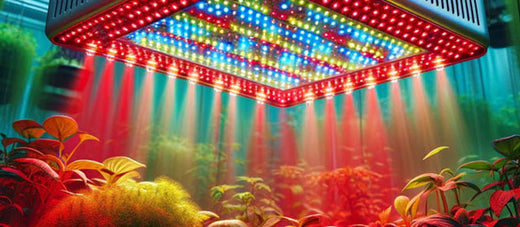Growing cannabis can be a fun and educational hobby, especially if you're aiming for high-quality medicinal marijuana.
Although it doesn't have to be complicated in theory, mistakes can still be made – especially if you 're new to using LED grow lights .
➡️ In this blog you will discover the most common mistakes and how you can easily avoid them for a successful harvest.
Benefits of LED grow lights
In the past, growers mainly used HID (High-Intensity Discharge) lamps , such as:
-
MH (Metal Halide) lamps for the growth phase
-
HPS (High-Pressure Sodium) lamps for the flowering phase
Today, LED grow lights are quickly gaining ground in grow rooms around the world, thanks to their many advantages:
✅ Lower energy consumption
LED lights use significantly less electricity than HID lights.
This not only lowers your energy bill, but is also better for the environment.
✅ Less heat production
LED lights emit less heat, which is ideal for smaller grow rooms and helps prevent overheating.
✅ Affordability
The widespread use of LED technology has made high-quality LED lamps increasingly affordable.
Even with the best equipment, things can go wrong.
Here are 7 common mistakes you absolutely want to avoid:
1. ❌ Incorrect distance between LED lamp and plants
Many growers place their LED lights too far away or too close to the plants:
-
Too far away:
Plants stretch towards the light, developing long, weak stems. -
Too close to:
Leaves and buds can burn or bleach from excessive light and heat radiation.
💡 Tip:
Always consult the manufacturer's manual.
General guideline:
-
During the growth phase : 30–40 cm distance
-
During the flowering phase : minimum distance 15 cm
2. ❌ Overwatering
Because HID lights emit more heat, the soil dries out faster.
With LED lamps the soil stays moist for longer , which requires an adjusted watering schedule.
-
Too much water:
This can lead to root rot, mold, and other problems.
💧 Watering tip:
Let the topsoil dry out before watering again. Feel it with your finger!
3. ❌ Using the wrong type of LED light
Not all LED lights are the same.
Your choice should match the growth stage of your plants:
-
Grow lights:
Bluish light, ideal for the vegetative phase. -
Flowering bulbs:
Reddish light, perfect for the flowering phase.
🌈 Full spectrum LED lights are currently the most practical choice for growers who want to support both phases.
4. ❌ Buying low-quality LED grow lights
Cheap LED lights seem attractive, but often have:
-
Poor light distribution
-
Low light intensity
-
Less sustainability
💡 Always invest in quality :
Choose lamps from reputable brands with good reviews and guarantees.
5. ❌ Not providing enough light
Please note: The wattage of a bulb only indicates how much energy it uses, not how much light it produces.
-
Important benchmark:
Photon Flux Density (PFD) – this measures how much light actually reaches your plants.
🔆 Rule of thumb:
A 300W LED grow light is suitable for approximately one square meter of planting surface.
6. ❌ Insufficient ventilation
Although LED grow lights produce less heat than HPS lights, ventilation remains essential:
-
Fresh air supply brings in sufficient carbon dioxide (CO₂) , necessary for photosynthesis.
-
Air circulation prevents heat, mold formation and pests.
🌬️ Ensure constant airflow in your grow room for optimal plant health.
7. ❌ Using the wrong lighting schedule
Depending on the type of cannabis seed, you use different light schedules:
-
Autoflowering seeds:
Grow from seed to harvest under 18–24 hours of light per day. -
Photoperiod seeds:
Require 18–24 hours of light during the vegetative phase, followed by 12 hours on / 12 hours dark to initiate flowering.
🕒 Match your light cycle to the type of plants you're growing!
Conclusion: Grow with care, knowledge and patience
Using LED grow lights offers enormous advantages for growing cannabis indoors.
By avoiding common mistakes and paying close attention to spacing, watering, light quality, and ventilation, you increase your chances of a rich and healthy harvest.
🌱 With the right care and a little patience, your growing adventure will be a great success!
💡 Extra tip:
Want more tips on lighting, growing schedules, and care? Then check out our other articles on our blog !

